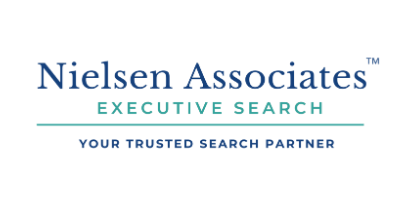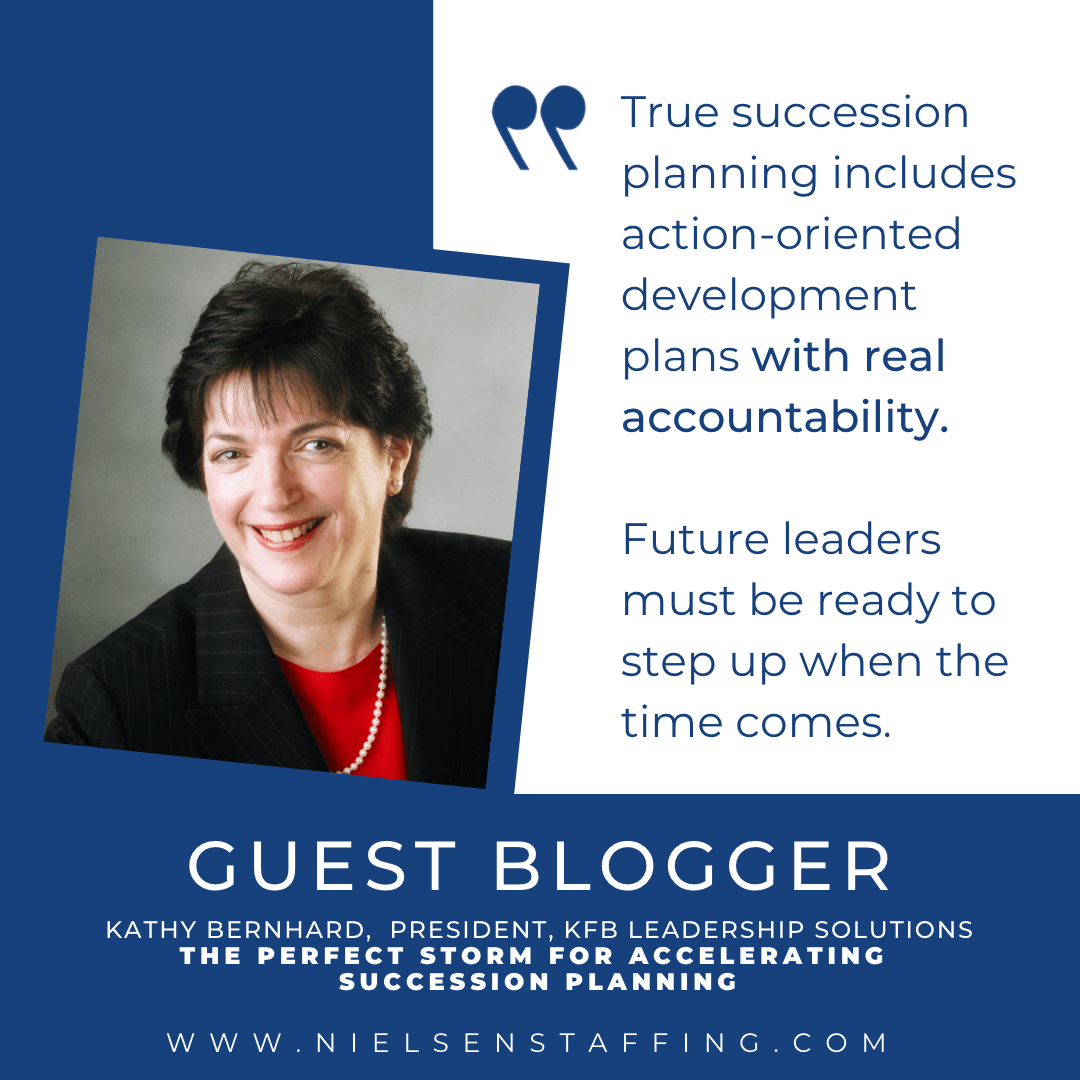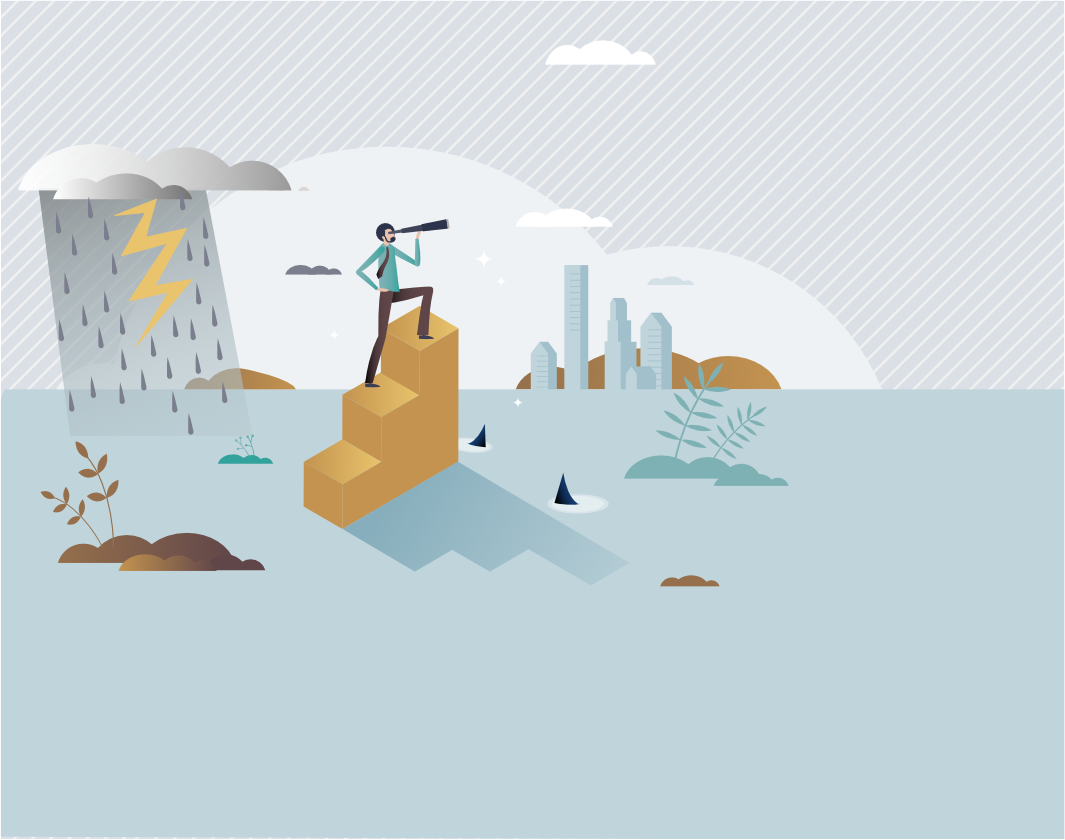The Perfect Storm for Accelerating Succession Planning
We’re launching a new guest blogger program; and we’re excited to introduce our first contributor, Kathy Bernhard. Our goal is to seek out the experts who have real-world experience, and invite them to share their business wisdom with you.
Close your eyes and imagine a world where there was a choice of at least three “Ready Now” successors for each senior-level executive or critical position in your business. What would that be worth to your organization?
Most of you probably would have said this was a pretty tall order before March 2020, when a loud voice said “freeze,” and it seemed like everything we thought we knew about succession (and a lot of other things) suddenly shifted. I have been doing this work for many years, and we used to emphasize the HOW-TO. In today’s (almost) post-COVID world, I think it’s even more important to start with the WHY.
I wish I could tell you that if you keep reading, you’ll find the magic formula to make meaningful succession planning a reality, but unfortunately that would be a bit of an exaggeration. What I can promise is to share some thought leadership to bring you a little closer to “talent nirvana” AND prepare you to make the business case for why the stakes have been raised to make succession planning a top strategic priority, now more than ever.
Whatever you are currently doing in succession planning, trust me, it’s no longer enough. Here’s why: Once the pandemic began, everything about the critical nature of succession was suddenly magnified. It became more complex; we had more wild card variables; and a lot of organizations were struck by the very real reality that everything they thought they knew for sure about succession was suddenly no longer certain. Wherever you are right now in succession planning, whatever your starting position (including not yet doing anything at all), it’s time to make the business case to take your efforts to the next level. Succession planning is in fact another form of business continuity planning. It’s not possible to execute even the most perfect business strategy without having the right talent in the right place to make it happen. A combination of events, including the pandemic, have created a perfect storm to accelerate succession planning efforts immediately. Let’s look at each of these factors individually.
THE PERFECT STORM FOR ACCELERATING
SUCCESSION PLANNING
- Implications from the Pandemic
- Heightened Emphasis on DE&I
- The Future of Work
Implications from the Pandemic
There are impacts on both organizations as well as individuals. While some industries have been impacted more than others, all were jolted by what “could have happened”, even if we were lucky enough to escape real damage this time. Further, some aspects of business may be gone forever; and new aspects may have emerged. How many times have you heard the word “PIVOT” in the past year and a half? Pivoting has huge implications for the talent and skills required to execute the strategy we’re suddenly pivoting to. Of course, ongoing uncertainty about strategy will continue to have implications for roles and skills needed to win in the marketplace. Some organizations learned that a critical leader never tested in a crisis wasn’t up to the challenge, may be burned out, or became ill.
For individuals, the pandemic prompted people to take stock and reflect on what they want to do with their lives; and equally important, where they want to do it from, and how much time they want to spend doing it. Understandably, many are concerned about or dealing with burnout. These factors are likely to result in more churn. People are deciding whether this is the time to make a job change. During periods of high churn, prudent organizations place even more emphasis on building internal talent rather than buying it externally, and drive succession planning deeper into the organization. This is a wise retention AND development strategy.
Whatever the specifics for your organization, succession planning must be a priority, and whatever plans are in place need to be revisited with an increased sense of urgency and acceleration. Industry leaders including Korn Ferry agree:
WHAT THE EXPERTS
ARE SAYING
As early as March 2020, Korn Ferry noted that executive succession plans are being uniquely impacted by the global uncertainty of the pandemic. They advised to:
- Prioritize the most critical roles and people to keep the business solvent.
- Run through business scenarios before making talent decisions but act fast.
- Accept that you will need to take talent risks that might not all prove to be right and/or that conditions may change.
Adapted from: “Executive Succession through the Lens of COVID-19”, Korn Ferry, March 30, 2020.
Heightened Emphasis on DE&I (Diversity, Equity, and Inclusion)
In May 2020, there was another seminal event with huge implications for succession planning — the myriad calls for racial justice following the killing of George Floyd, which prompted companies to evaluate diversity and inclusion practices at the urging of employees, shareholders, boards, and the general public. Suddenly, the whole ecosystem of an organization’s talent practices was under a microscope; and businesses were expected not only to speak, but also to take concrete actions to accelerate diversity, equity, and inclusion. Again, there are huge implications for succession planning and all talent practices. How do you continue to make your pipeline and your bench even more diverse, while at the same time helping those already in the pipeline acquire new leadership skills required post-pandemic?
MORE ABOUT DE&I and SUCCESSION PLANNING
- Starts at the top: Board and C-Suite.
- What matters gets measured.
- Comprehensive review of full talent ecosystem; starting with job descriptions, and sourcing.
- How do we make sure those included in Talent Reviews and on succession inventories are more diverse than in the past?
- How do we use tools like sponsorship to make sure that people other than white males are advancing on an accelerated basis?
- What changes are
necessary to your current Succession Planning processes to ensure this focus?
The Future of Work
Before the pandemic, we started hearing about “the future of work,” and the new skills that would be required. Suddenly businesses began weighing the value and role of artificial intelligence, machine learning, robotics, remote/hybrid work, green jobs, climate change, etc. All these new areas are still enormous opportunities, but the pandemic’s impact on how people work and where they are working from - has huge implications for skills, especially for leaders. Suddenly, we need to develop and measure a new combination of skills that may or may not have been as important previously.
As if this isn’t enough to be concerned about, there are some traditional challenges that still must be addressed for succession planning efforts to generate real business value:
- Challenge #1: Don’t fall into the trap of thinking just because you have a list of replacement names on an organization chart that you have a solid succession plan. True succession planning includes action-oriented development plans with real accountability. Future leaders must be ready to step up when the time comes. Otherwise, all you really have is a list of names.
- Challenge #2: Succession planning often fails to generate value because it is nothing more than another “administrative HR project.” While HR plays a key role, accountability for results and execution of development plans must be real and rest with business leaders.
- Challenge #3: “To tell or not to tell.” Each organization must decide how much candor and transparency they want as a part of their communications about succession planning. Some organizations explicitly tell people they are succession candidates, while others keep the process shrouded in secrecy. I would advocate for candor, but not absolute candor; meaning I would stop short of telling someone they are the definite successor to someone else. However, I would make it clear in every way possible that the person has a lot of career runway ahead; and with sustained high performance s/he can expect significant career progression. To go further than that runs the risk of making an implied contract, one that might not be able to be honored. Whatever the decision about transparency, the key is that it is applied in a standard way in all parts of the business.
Succession planning is an important and often a complex job. What works in one organization can be overkill in another. A good rule of thumb is to start small and only collect the minimum amount of information necessary to make a good decision. But the call to action is compelling. Wherever you are in the process, what steps can you take now to make succession planning more of a value-added competitive differentiator for your business?
More about Kathy Bernhard:
Prior to forming her own practice, KFB Leadership Solutions, Kathy held several HR Leadership positions and has served as the Director of Human Resources and Director of Organization Development for companies in a variety of industries. She has more than 30 years of corporate experience, and has served as lead facilitator and curriculum designer for Stony Brook University’s Women in STEM Leadership program. Her work on mentoring has been summarized in McKinsey & Company’s 2001 Book, “The War for Talent,” and she is a valued contributor on Forbes Coaches Council. To connect with Kathy, visit her on LinkedIn.













